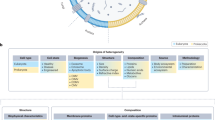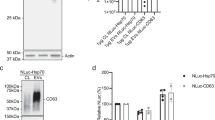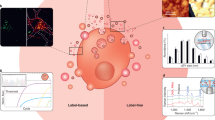Abstract
Extracellular vesicles (EVs) are small particles with phospholipid bilayers that carry a diverse range of cargoes including nucleic acids, proteins and metabolites. EVs have important roles in various cellular processes and are increasingly recognized for their ubiquitous role in cell–cell communications and potential applications in therapeutics and diagnostics. Although many methods have been developed for the characterization and measurement of EVs, analyzing them from biofluids remains a challenge with regard to throughput and sensitivity. Recently, we introduced an approach to facilitate high-throughput analysis of EVs from trace amounts of sample. In this method, an amphiphile–dendrimer supramolecular probe (ADSP) is coated onto a nitrocellulose membrane for array-based capture and to enable an in situ immunoblotting assay. Here, we describe the protocol for our array-based method of EV profiling. We describe an enhanced version of the method that incorporates an automated printing workstation, ensuring high throughput and reproducibility. We further demonstrate the use of our array to profile specific glycosylations on the EV surface using click chemistry of an azide group introduced by metabolic labeling. In this protocol, the synthesis of ADSP and the fabrication of ADSP nitrocellulose membrane array can be completed on the same day. EVs are efficiently captured from biological or clinical samples through a 30-min incubation, followed by an immunoblotting assay within a 3-h window, thus providing a high-throughput platform for EV isolation and in situ targeted analysis of EV proteins and their modifications.
Key points
-
This protocol uses an amphiphile–dendrimer supramolecular probe to capture extracellular vesicles from biofluids and cell culture medium to avoid time-consuming sample processing and the cocapture of nucleic acids and proteins associated with ultracentrifugation-based purification approaches.
-
The use of a chemical affinity probe coating onto nitrocellulose membrane enables high-throughput, array-based enrichment and in situ immunoblotting of extracellular vesicle proteins for relative concentration assay.
This is a preview of subscription content, access via your institution
Access options
Access Nature and 54 other Nature Portfolio journals
Get Nature+, our best-value online-access subscription
27,99 € / 30 days
cancel any time
Subscribe to this journal
Receive 12 print issues and online access
269,00 € per year
only 22,42 € per issue
Buy this article
- Purchase on SpringerLink
- Instant access to full article PDF
Prices may be subject to local taxes which are calculated during checkout







Similar content being viewed by others
Data availability
The authors declare that the main data discussed in this protocol are available in the supporting primary research papers. Further parameters or details of the experiments are available from the corresponding author upon reasonable request.
References
Kalluri, R. & LeBleu, V. S. The biology, function, and biomedical applications of exosomes. Science https://doi.org/10.1126/science.aau6977 (2020).
Cocucci, E. & Meldolesi, J. Ectosomes and exosomes: shedding the confusion between extracellular vesicles. Trends Cell Biol. 25, 364–372 (2015).
Théry, C. et al. Minimal information for studies of extracellular vesicles 2018 (MISEV2018): a position statement of the International Society for Extracellular Vesicles and update of the MISEV2014 guidelines. J. Extracell. Vesicles 7, 1535750 (2018).
Marar, C., Starich, B. & Wirtz, D. Extracellular vesicles in immunomodulation and tumor progression. Nat. Immunol. 22, 560–570 (2021).
Buzas, E. I. The roles of extracellular vesicles in the immune system. Nat. Rev. Immunol. 23, 236–250 (2023).
Lou, P. et al. Neonatal-tissue-derived extracellular vesicle therapy (NEXT): a potent strategy for precision regenerative medicine. Adv. Mater. 35, e2300602 (2023).
Dixson, A. C., Dawson, T. R., Di Vizio, D. & Weaver, A. M. Context-specific regulation of extracellular vesicle biogenesis and cargo selection. Nat. Rev. Mol. Cell Biol. 24, 454–476 (2023).
Villarroya-Beltri, C. et al. Sumoylated hnRNPA2B1 controls the sorting of miRNAs into exosomes through binding to specific motifs. Nat. Commun. 4, 2980 (2013).
Tkach, M. & Théry, C. Communication by extracellular vesicles: where we are and where we need to go. Cell 164, 1226–1232 (2016).
Kourembanas, S. Exosomes: vehicles of intercellular signaling, biomarkers, and vectors of cell therapy. Annu. Rev. Physiol. 77, 13–27 (2015).
Kalluri, R. & McAndrews, K. M. The role of extracellular vesicles in cancer. Cell 186, 1610–1626 (2023).
Becker, A. et al. Extracellular vesicles in cancer: cell-to-cell mediators of metastasis. Cancer Cell 30, 836–848 (2016).
Melo, S. A. et al. Glypican-1 identifies cancer exosomes and detects early pancreatic cancer. Nature 523, 177–182 (2015).
Yu, D. et al. Exosomes as a new frontier of cancer liquid biopsy. Mol. Cancer https://doi.org/10.1186/s12943-022-01509-9 (2022).
Boukouris, S. & Mathivanan, S. Exosomes in bodily fluids are a highly stable resource of disease biomarkers. Proteom. Clin. Appl. 9, 358–367 (2015).
Martins, T. S., Catita, J., Rosa, I. M., Silva, O. & Henriques, A. G. Exosome isolation from distinct biofluids using precipitation and column-based approaches. PLoS ONE https://doi.org/10.1371/journal.pone.0198820 (2018).
Chen, J. C. et al. Review on strategies and technologies for exosome isolation and purification. Front. Bioeng. Biotechnol. https://doi.org/10.3389/fbioe.2021.811971 (2022).
Guan, S. et al. Characterization of urinary exosomes purified with size exclusion chromatography and ultracentrifugation. J. Proteome Res. 19, 2217–2225 (2020).
Pathan, M. et al. Vesiclepedia 2019: a compendium of RNA, proteins, lipids and metabolites in extracellular vesicles. Nucleic Acids Res. 47, D516–D519 (2019).
Omrani, M. et al. Global trend in exosome isolation and application: an update concept in management of diseases. Mol. Cell Biochem. https://doi.org/10.1007/s11010-023-04756-6 (2023).
Sódar, B. W. et al. Low-density lipoprotein mimics blood plasma-derived exosomes and microvesicles during isolation and detection. Sci. Rep. 6, 24316 (2016).
Gardiner, C. et al. Techniques used for the isolation and characterization of extracellular vesicles: results of a worldwide survey. J. Extracell. Vesicles 5, 32945 (2016).
Jeppesen, D. K. et al. Comparative analysis of discrete exosome fractions obtained by differential centrifugation. J. Extracell. Vesicles 3, 25011 (2014).
Welton, J. L. et al. Proteomics analysis of vesicles isolated from plasma and urine of prostate cancer patients using a multiplex, aptamer-based protein array. J. Extracell. Vesicles 5, 31209 (2016).
Wu, X. F., Li, L., Iliuk, A. & Tao, W. A. Highly efficient phosphoproteome capture and analysis from urinary extracellular vesicles. J. Proteome Res. 17, 3308–3316 (2018).
Sun, J. et al. Profiling phosphoproteome landscape in circulating extracellular vesicles from microliters of biofluids through functionally tunable paramagnetic separation. Angew. Chem. Int. Ed. https://doi.org/10.1002/anie.202305668 (2023).
Feng, X. et al. Supramolecular exosome array for efficient capture and in situ detection of protein biomarkers. Anal. Chem. 95, 2812–2821 (2023).
Dong, P. T. et al. Polarization-sensitive stimulated Raman scattering imaging resolves amphotericin B orientation in Candida membrane. Sci. Adv https://doi.org/10.1126/sciadv.abd5230 (2021).
Feng, X. et al. Proteomic discovery and array-based validation of biomarkers from urinary exosome by supramolecular probe. J. Proteome Res. https://doi.org/10.1021/acs.jproteome.3c00063 (2023).
Koide, R. et al. Antiadhesive nanosome elicits role of glycocalyx of tumor cell-derived exosomes in the organotropic cancer metastasis. Biomaterials 280, 121314 (2022).
Chauhan, S. et al. Surface glycoproteins of exosomes shed by myeloid-derived suppressor cells contribute to function. J. Proteome Res. 16, 238–246 (2017).
Linares, R., Tan, S., Gounou, C., Arraud, N. & Brisson, A. R. High-speed centrifugation induces aggregation of extracellular vesicles. J. Extracell. Vesicles 4, 29509 (2015).
Martín-Gracia, B. et al. Nanoparticle-based biosensors for detection of extracellular vesicles in liquid biopsies. J. Mater. Chem. B 8, 6710–6738 (2020).
Castillo, J. et al. Surfaceome profiling enables isolation of cancer-specific exosomal cargo in liquid biopsies from pancreatic cancer patients. Ann. Oncol. 29, 223–229 (2018).
Zhou, J. et al. Epitope imprinting of phospholipids by oriented assembly at the oil/water interface for the selective recognition of plasma membranes. Angew. Chem. Int. Ed. 62, e202213938 (2023).
Gao, F. Y. et al. A novel strategy for facile serum exosome isolation based on specific interactions between phospholipid bilayers and TiO2. Chem. Sci. 10, 1579–1588 (2019).
Pugholm, L. H., Revenfeld, A. L., Søndergaard, E. K. & Jørgensen, M. M. Antibody-based assays for phenotyping of extracellular vesicles. BioMed. Res. Int. 2015, 524817 (2015).
MacBeath, G. & Schreiber, S. L. Printing proteins as microarrays for high-throughput function determination. Science 289, 1760–1763 (2000).
Liu, Y. K. et al. One-pot analytical pipeline for efficient and sensitive proteomic analysis of extracellular vesicles. J. Proteome Res. 22, 3301–3310 (2023).
Lee, Z. C., Hadisurya, M., Luo, Z., Li, L. & Tao, W. A. Hands-free proteomic profiling of urinary extracellular vesicles with a high-throughput automated workflow. J. Am. Soc. Mass. Spectrom. 34, 2585–2593 (2023).
Pan, L., Aguilar, H. A., Wang, L., Iliuk, A. & Tao, W. A. Three-dimensionally functionalized reverse phase glycoprotein array for cancer biomarker discovery and validation. J. Am. Chem. Soc. 138, 15311–15314 (2016).
Zhang, Y. et al. High-throughput phosphorylation screening and validation through Ti(IV)-nanopolymer functionalized reverse phase phosphoprotein array. Anal. Chem. 90, 10263–10270 (2018).
Chen, I. H. et al. Analytical pipeline for discovery and verification of glycoproteins from plasma-derived extracellular vesicles as breast cancer biomarkers. Anal. Chem. 90, 6307–6313 (2018).
Baghirova, A. A. & Kasumov, K. M. Antifungal macrocycle antibiotic amphotericin B—its present and future. Multidisciplinary perspective for the use in the medical practice. Biochem. Mosc. Suppl. B 16, 1–12 (2022).
Cavassin, F. B., Bau-Carneiro, J. L., Vilas-Boas, R. R. & Queiroz-Telles, F. Sixty years of amphotericin B: an overview of the main antifungal agent used to treat invasive fungal infections. Infect. Dis. Ther. 10, 115–147 (2021).
Lozano-Andrés, E. et al. Physical association of low density lipoprotein particles and extracellular vesicles unveiled by single particle analysis. J. Extracell. Vesicles 12, e12376 (2023).
Simonsen, J. B. What are we looking at? Extracellular vesicles, lipoproteins, or both? Circ. Res. 121, 920–922 (2017).
Yuana, Y. et al. Handling and storage of human body fluids for analysis of extracellular vesicles. J. Extracell. Vesicles https://doi.org/10.3402/jev.v4.29260 (2015).
Iliuk, A. et al. Plasma-derived extracellular vesicle phosphoproteomics through chemical affinity purification. J. Proteome Res. 19, 2563–2574 (2020).
Shen, A. et al. High-throughput proteomic analysis of extracellular vesicles from saliva by chemical probe-based array. Anal. Chim. Acta 1309, 342699 (2024).
Daassi, D., Mahoney, K. M. & Freeman, G. J. The importance of exosomal PDL1 in tumour immune evasion. Nat. Rev. Immunol. 20, 209–215 (2020).
Costa, J. Glycoconjugates from extracellular vesicles: structures, functions and emerging potential as cancer biomarkers. Biochim. Biophys. Acta Rev. Cancer 1868, 157–166 (2017).
Ragni, E. et al. Protein O-mannosylation is crucial for human mesencyhmal stem cells fate. Cell. Mol. Life Sci. 73, 445–458 (2015).
Williams, C. et al. Glycosylation of extracellular vesicles: current knowledge, tools and clinical perspectives. J. Extracell. Vesicles https://doi.org/10.1080/20013078.2018.1442985 (2018).
Gao, L. et al. Legionella effector SetA as a general O-glucosyltransferase for eukaryotic proteins. Nat. Chem. Biol. 15, 213–216 (2019).
Lobb, R. J. et al. Optimized exosome isolation protocol for cell culture supernatant and human plasma. J. Extracell. Vesicles 4, 27031 (2015).
Shao, H. et al. New technologies for analysis of extracellular vesicles. Chem. Rev. 118, 1917–1950 (2018).
Vogel, R. et al. A standardized method to determine the concentration of extracellular vesicles using tunable resistive pulse sensing. J. Extracell. Vesicles 5, 31242 (2016).
Yuana, Y. et al. Cryo-electron microscopy of extracellular vesicles in fresh plasma. J. Extracell. Vesicles https://doi.org/10.3402/jev.v2i0.21494 (2013).
Sharma, S. et al. Structural-mechanical characterization of nanoparticle exosomes in human saliva, using correlative AFM, FESEM, and force spectroscopy. ACS Nano 4, 1921–1926 (2010).
Yang, Q. et al. Metabolomic investigation of urinary extracellular vesicles for early detection and screening of lung cancer. J. Nanobiotechnol. 21, 153 (2023).
Lokumcu, T. et al. Proteomic, metabolomic, and fatty acid profiling of small extracellular vesicles from glioblastoma stem-like cells and their role in tumor heterogeneity. ACS Nano 18, 2500–2519 (2024).
Andaluz Aguilar, H., Iliuk, A. B., Chen, I. H. & Tao, W. A. Sequential phosphoproteomics and N-glycoproteomics of plasma-derived extracellular vesicles. Nat. Protoc. 15, 161–180 (2020).
Ricklefs, F. L. et al. Immune evasion mediated by PD-L1 on glioblastoma-derived extracellular vesicles. Sci. Adv. https://doi.org/10.1126/sciadv.aar2766 (2018).
Ye, L. et al. Prognostic significance and functional relevance of olfactomedin 4 in early-stage hepatocellular carcinoma. Clin. Transl. Gastroen. 11, e00124 (2020).
Bausch-Fluck, D. et al. A mass spectrometric-derived cell surface protein atlas. PLoS ONE https://doi.org/10.1371/journal.pone.0121314 (2015).
Bausch-Fluck, D. et al. The in silico human surfaceome. Proc. Natl Acad. Sci. USA 115, E10988–E10997 (2018).
Rai, A., Fang, H. Y., Claridge, B., Simpson, R. J. & Greening, D. W. Proteomic dissection of large extracellular vesicle surfaceome unravels interactive surface platform. J. Extracell. Vesicles https://doi.org/10.1002/jev2.12164 (2021).
Li, Y., Wang, J., Chen, W., Lu, H. & Zhang, Y. Comprehensive review of MS-based studies on N-glycoproteome and N-glycome of extracellular vesicles. Proteomics https://doi.org/10.1002/pmic.202300065 (2023).
Lee, H. H. et al. Removal of N-linked glycosylation enhances PD-L1 detection and predicts anti-PD-1/PD-L1 therapeutic efficacy. Cancer Cell 36, 168–178.e164 (2019).
Acknowledgements
We sincerely thank X. Zhang at Jilin University/Tsinghua University for the help on concept proposing and experimental design of the project. This work was funded by National Science Foundation of China (22374056, 22174021), National Key R&D Program of China (2020YFE0202200, 2023YFA0915300) and Proteomic Navigator of The Human Body Project (π-HuB project).
Author information
Authors and Affiliations
Contributions
X.F., A.S. and L.H. designed the experimental protocol. X.F., A.S. and W.Z. performed all the experiments with help from S.J., A.I., Y.Z., Y.W. and W.Z. X.F. and A.S. wrote the manuscript with help from A.I., Y.Z., Y.W., W.Z. and W.A.T. X.F., A.S., W.A.T. and L.H. approved the final version. Y.Z., Y.W., W.Z., L.H. and W.A.T. provided advice and infrastructural support.
Corresponding authors
Ethics declarations
Competing interests
The authors declare no competing interests.
Peer review
Peer review information
Nature Protocols thanks Dennis Jeppesen and the other, anonymous, reviewer(s) for their contribution to the peer review of this work.
Additional information
Publisher’s note Springer Nature remains neutral with regard to jurisdictional claims in published maps and institutional affiliations.
Key references
Feng, X. et al. Anal. Chem. 95, 2812–2821 (2023): https://doi.org/10.1021/acs.analchem.2c04190
Feng, X. et al. J. Proteome Res. 22, 2516–2524 (2023): https://doi.org/10.1021/acs.jproteome.3c00063
Shen, A. et al. Anal. Chim. Acta. 1309, 342699 (2024): https://doi.org/10.1016/j.aca.2024.342699
Extended data
Extended Data Fig. 1 Flowchart for metabolic glycan labeling of cells and array-based EV capture/detection.
a. Metabolic glycan labeling of cells. b. Collection of cell culture medium and click chemistry reaction of EVs. c. ADSP array-based capture of EVs and fluorescent detection of labeled glycans. Figure created using BioRender.
Extended Data Fig. 2 The synthesized ADSP solution and the use of ADSP to modify the membranes.
a. ADSP solution after dialysis. The A340 is ~0.62. b. The ADSP-modified NC membrane finished product. Left: blank membrane, right: ADSP-modified membrane. c. ADSP solution measured at 340 nm after each modification to show the content. The overall use of ADSP solution is 0.24 mL per cm2 membrane. The effectiveness of the array after each modification is shown, demonstrating that ADSP below an A340 of 0.4 might be insufficient for modification.
Extended Data Fig. 3 Distribution and flow cytometry charts of EVs captured by ADSP array, generated using nanoflow cytometry.
“Plasma”, “Urine” and “Cell culture medium” refer to particles from different samples captured by and eluted from the ADSP-coated membrane, respectively. “Original” refers to particles from plasma samples captured and eluted by the ADSP-coated membrane. “Filtrate” represents the sEVs obtained from the original sample after passing through a 0.22 μm membrane filter. “Residue” denotes the particles from the original sample retained on the membrane filter, which are collected by washing with PBS. a. Histograms depicting the distribution of particles obtained from the plasma, urine, and cell culture medium. b. A size reference chart provided by Apogee for standard microspheres, enabling the determination of the size distribution of the test sample based on comparison with the standard microspheres. The term 4-9 with “black gate” refers to different populations of particles with varying particle sizes, whereas the term 1-3 with “red gate” signifies particle populations with different sizes and the presence of fluorescence signals. c. The Original, Filtrate, and Residue samples are stained with a membrane dye DiO and subsequently subjected to detection through the 488-channel by Apogee. Particles exhibiting fluorescence signals above the red line are identified as particles having membrane structures, while those below are considered as lacking membrane structures. Among the particles above the red line, those with membrane structures and falling within the size range to the left of the black line are identified as sEVs, while those to the right are categorized as lEVs.
Extended Data Fig. 4 Comparison of EVs enrichment efficiency between ADSP-membrane and UC with characterization by NTA.
Comparison of EV enrichment efficiency between ADSP-membrane and ultracentrifugation using NTA. a–c show NTA characterization of plasma, urine and cell culture medium derived EVs captured by an ADSP membrane. The original volume of samples is: a. 10 µL of plasma diluted using PBS to a final volume of 2 mL; b. 2 mL of urine samples; c. 2 mL of cell culture medium samples. d–f show NTA characterization of plasma, urine and cell culture medium derived EVs enriched by ultracentrifugation. Original volumes of plasma, urine and cell culture medium were the same as a–c. DPBS was used to adjust the ultracentrifugation precipitate to 1 mL for NTA assay.
Supplementary information
Supplementary Video 1
The use of the automated pipetting workstation for array-based capture of EVs.
Supplementary Video 2
The use of Smart Blotter for array-based capture of EVs.
Rights and permissions
Springer Nature or its licensor (e.g. a society or other partner) holds exclusive rights to this article under a publishing agreement with the author(s) or other rightsholder(s); author self-archiving of the accepted manuscript version of this article is solely governed by the terms of such publishing agreement and applicable law.
About this article
Cite this article
Feng, X., Shen, A., Zhang, W. et al. High-throughput capture and in situ protein analysis of extracellular vesicles by chemical probe-based array. Nat Protoc 20, 1057–1081 (2025). https://doi.org/10.1038/s41596-024-01082-z
Received:
Accepted:
Published:
Issue Date:
DOI: https://doi.org/10.1038/s41596-024-01082-z



